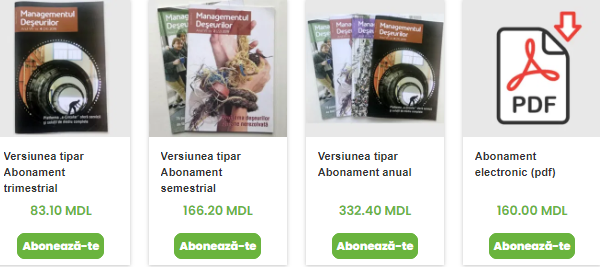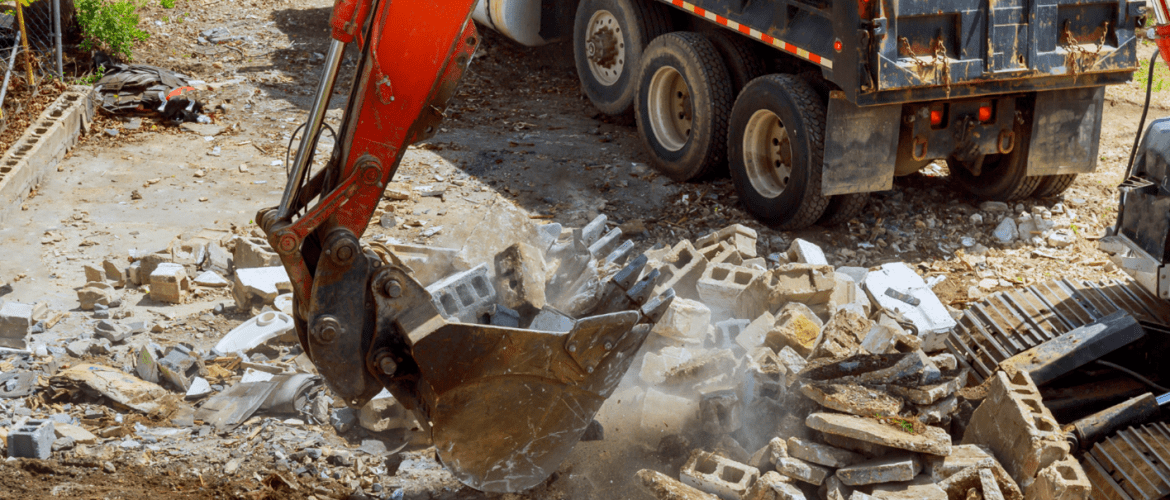Construction and demolition waste (DCD) = waste resulting from construction, renovation, rehabilitation, repair, consolidation, demolition of civil constructions, industrial constructions, building structures, transport infrastructure as well as dredging and unclogging activities , including soil excavated from contaminated sites. They are generated through a discontinuous process and their composition is very heterogeneous, containing remnants of construction materials, chemical products and other auxiliary materials. Aroape 80% of the amount of debris generated results from civil constructions (buildings), and the rest from civil constructions, roads and bridges. Approximately 3% of the materials used become rubble from the construction phase. Certain materials from this waste are recoverable, others require special treatment.
These specific wastes are identified as a priority stream by the EU, being a potential source for recycling and reuse in the construction industry. Reusing building materials is nothing new, we've been dismantling and rebuilding for many years in our history because it was the natural way of things. After the Second World War, the paradigm changed, economic growth became the focal point and not resource efficiency. By point of view ecological, the reuse of construction and demolition waste reduces the space intended for authorized waste dumps and allows a saving of natural resources. By point of view economic, the use of recycled materials instead of natural resources, which reach extremely high costs, becomes an increasingly advantageous solution from one year to the next.
In the Republic of Moldova, today, things are no different, the rush for urbanization and growth is visible, which is also what the statistical data tell us. According to the National Bureau of Statistics, on elements of the structure of the executed works, îin 2019, compared to 2018, the volume of new construction works increased by 27.1%, and from the total volume of works executed in 2019, the largest share belongs to new construction works, which constituted 50.6%. Any new construction, demolition or reconstruction also means waste, often the materials used are toxic, such as asbestos. More waste is generated from renovation/modification works than from the construction works of a new building. Therefore, it is necessary to address the circularity and sustainability of materials used in construction.
The products and materials used in construction may contain highly toxic carcinogenic or allergenic compounds, irritant compounds and compounds with unknown toxic properties: degradation products, volatile and semi-volatile organic compounds (formaldehyde, aromatic organic solvents), antiparasitic compounds, biological pollutants (fungi, moss, bacteria), natural and artificial mineral fibers (asbestos, glass wool, basaltic mineral wool). After prolonged storage, some non-hazardous materials can become hazardous through contact with various polluting agents.
Producers and owners of construction and demolition waste do not pay enough attention to their management. Some construction companies conclude contracts with sanitation services for the collection of this waste, but it is not sorted by type of material, and it is only removed, not reused, recycled or recovered. Summing up all these aspects, it was concluded the need to develop a normative act (draft law) to regulate the management of construction and demolition waste with the responsibility of the owner of the construction activity and the local public administration authorities.
Data on the amounts of waste resulting from construction and demolition activities are not in the national statistics, but taking into account the increase in works in the field, the amount of this specific waste is also increasing. The lack of data is also caused by the fact that most of the waste in this category comes from large builders, who generally have several work points spread all over the country and do not have a strict, centralized record that provides information about the true size theirs. In other cases, this waste is disposed of in old municipal landfills without weighing or monitoring.
These things are also reflected in The waste management strategy in the Republic of Moldova for the years 2013-2027, approved by HG No. 248/2013, which emphasizes that after experience "formation of the construction and demolition waste rate in Romania and Latvia, it is expected that in the period 2010-2027 the amount of construction and demolition waste per capita in The Republic of Moldova will grow in relation to the growth of real GDP in the country. As a result, the total amount of construction and demolition waste will increase from 1.4 million tons in 2010 to 2.6 million tons in 2027". Moreover, in the same strategy, it is specified the need to take legal and organizational measures for the reuse, recycling or recovery of construction and demolition waste.
In the Action plan regarding the implementation of the Waste Management Strategy in the Republic of Moldova for the years 2013-2027, for the collection and treatment of specific waste, it is necessary to promote and implement the "producer responsibility" principle, or the more recently encountered Extended Producer Responsibility (REP). The specific action is found in the same plan "Creating capacities to treat waste contaminated with hazardous substances from construction and demolition, with a view to recovery or disposal", for which total costs of 54.3 million lei (3.5 million euros) were estimated. The action has a deadline of 2015-2017, with the Ministry of the Environment and APL responsible for implementation. Moreover, two funding sources were identified - 38.8 million lei from the National Ecological Fund and 15.5 million lei from external assistance. However, the monitoring indicators have not been clearly established and the results in the case of a capacity-building action are in the medium and long term, the concrete legislative framework remains to be expected in the coming years.
Concrete solutions for minimizing DCD are:
- avoiding execution solutions that require the use of a larger amount of raw material and that require a longer execution time;
- the most accurate calculation of material requirements;
- the use, as far as possible, of modular or prefabricated constructions that reduce the amount of waste produced both on the site and by suppliers, and that also allow for easier subsequent disassembly;
- the use of recycled or recovered materials;
- the use of environmentally friendly raw materials and technologies, for example: insulation from raw materials such as sheep's wool, wood fiber boards, ecological paints and plasters;
- the adoption of packaging return policies to material suppliers - this bringing benefits to both the construction company and the suppliers;
- careful storage and handling of materials on site.
- avoiding unnecessary demolitions, by carefully evaluating the existing structures and trying to integrate them into the new project;
- the choice of controlled demolition processes that allow the recovery and valorization of construction materials, such as wood, bricks, carpentry;
If they are not contaminated, some of the construction and demolition waste that can be processed and reused are:
Excavated earth uncontaminated, resulting from the execution of constructions or demolitions, can be used in the execution of new landfills, but also as materials for the daily covering of stored waste. Other uses of uncontaminated land include:
- closing household waste deposits and placing them in the landscape;
- creating buffer barriers for sound insulation;
- filling material for various constructions;
- support for the improvement of poor land.
concrete it can be recycled and transformed into a wide range of paving or drainage products. Crushed concrete can be used as aggregate for fresh concrete. For this purpose, they are crushed until they reach the usual size of the aggregate and the grades necessary to make a certain type of concrete. In addition to the necessary grades, crushing also results in dust, which in some cases can be added to the mixture, because it has been experimentally found that, depending on the destination of the concrete, this addition is beneficial.
Bricks and pavers they can be crushed for paving or drainage. Currently, various studies and laboratory tests are being carried out to use the mixture of stone and brick in the execution of the base layer of the roads. Bricks and pavers from demolitions can be reused, and without being crushed, in the execution of new constructions. The biggest impediment of this solution is the need to sort and clean the old mortar. During the cleaning stage, the bricks or pavers may crack, making it impossible to reuse them.
rubble is the construction material, (mix of bricks, mortar, plaster) from the demolition of the building and is classified as follows: Unloaded mineral rubble that can be subjected, after appropriate crushing and respecting the minimum requirements regarding granulation, to a recovery in the construction of roads , as a filling material. The resulting material that cannot be reused is transported to authorized warehouses. The loaded rubble contains substances that can pollute the soil and ground water. Debris recovery poses particular problems due to heterogeneous granulation. Their introduction as such in recycling facilities is not possible or becomes harmful, which requires primary processing.
Wood waste they can be easily contaminated, therefore their separate collection is indicated, especially separately from other liquid waste such as paints, oils and varnishes.
metal resulting from the demolitions is collected in containers and transported to the recycling facilities.
Plasterboard can be used in sound insulation or fireproofing. The fastening and jointing parts of plasterboard boards can be reused or recycled.
Glass from the demolition operation can be collected in containers and handed over to the processing industry.
In Romania, construction companies have the obligation to sort, reuse, recycle, eliminate waste from construction sites. Those who carry out construction work in their homes must request the services of sanitation companies or other companies specialized in this field. Also, there are some economic operators who own crushers, turning concrete and bricks into materials that can have further use. The material resulting from crushing must correspond to the quality and cost of the raw materials normally used. Currently, even in Romania, there are no rules regarding the quality of the material resulting from the treatment of construction and demolition waste, preventing its use in various applications (filling material for the construction of transport routes).
An example would be the company StoneCycling, which has found a way to turn this waste into products of greater value. The material is made with a proprietary grinder that grinds waste materials such as glass, bricks, concrete and even entire sinks into a powder. Bricks can be produced using up to 60% –100% waste. By crushing the powder into a specific mixture at a high temperature, a new stone-like material is produced that can be used to build again.

[1] https://www.legis.md/cautare/getResults?doc_id=67104&lang=ro
[2] https://www.legis.md/cautare/getResults?doc_id=67104&lang=ro
[3] https://intheloopgame.com/podcast/009/
[4] https://statistica.gov.md/newsview.php?l=ro&idc=168&id=6664

You can find the full article in the latest issue of Waste Management Magazine (no. 27 (3) 2020).
Subscribe now to be informed by sending an email to info@e-circular.org

